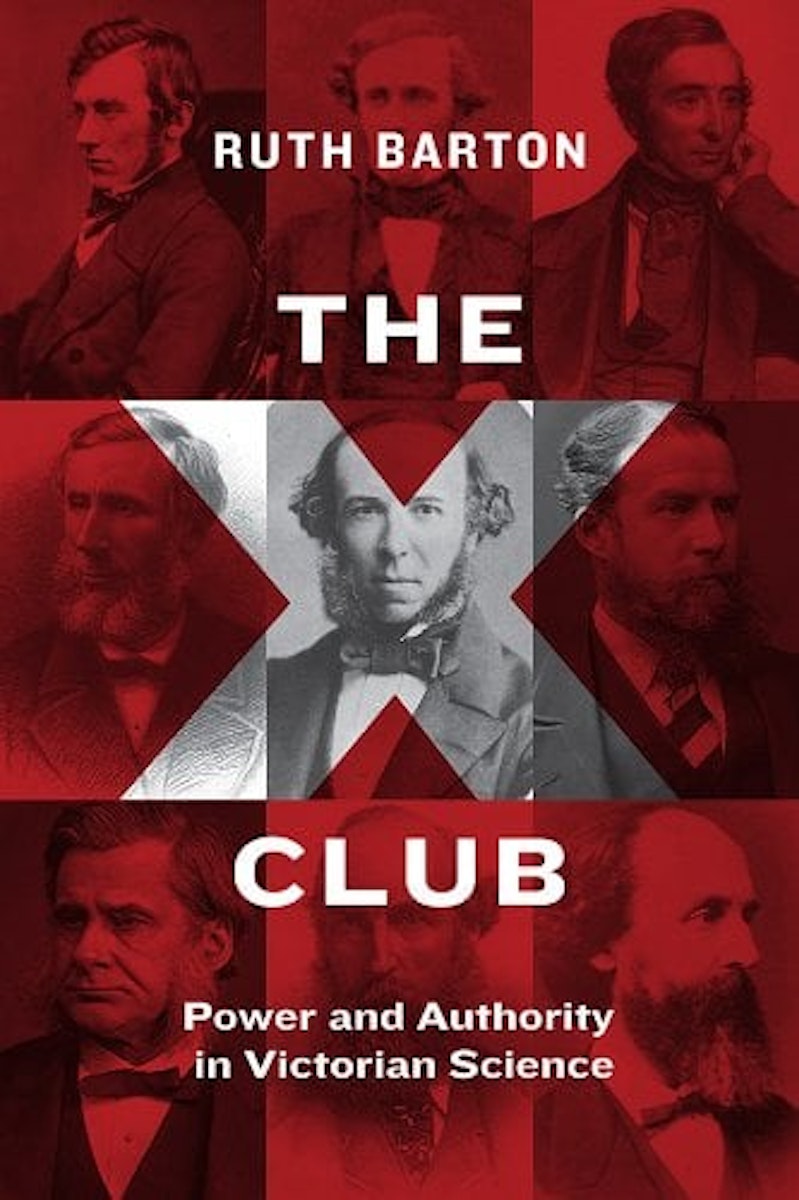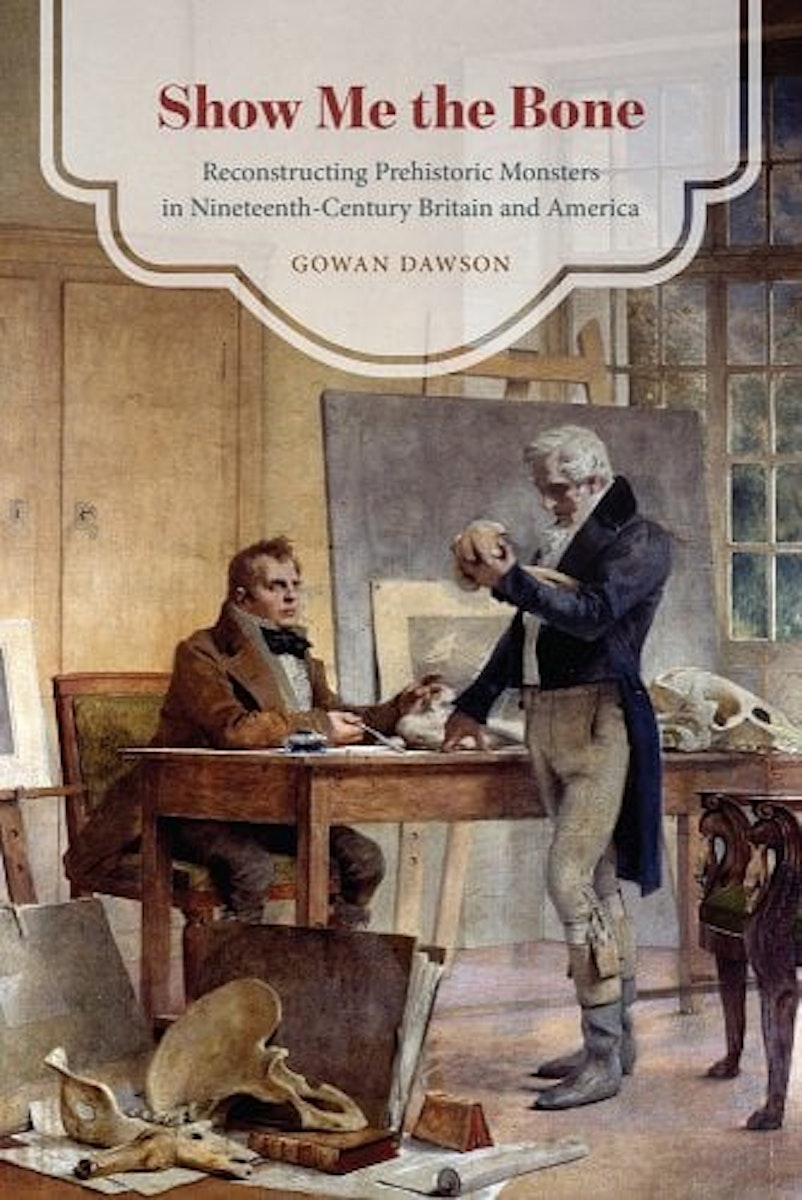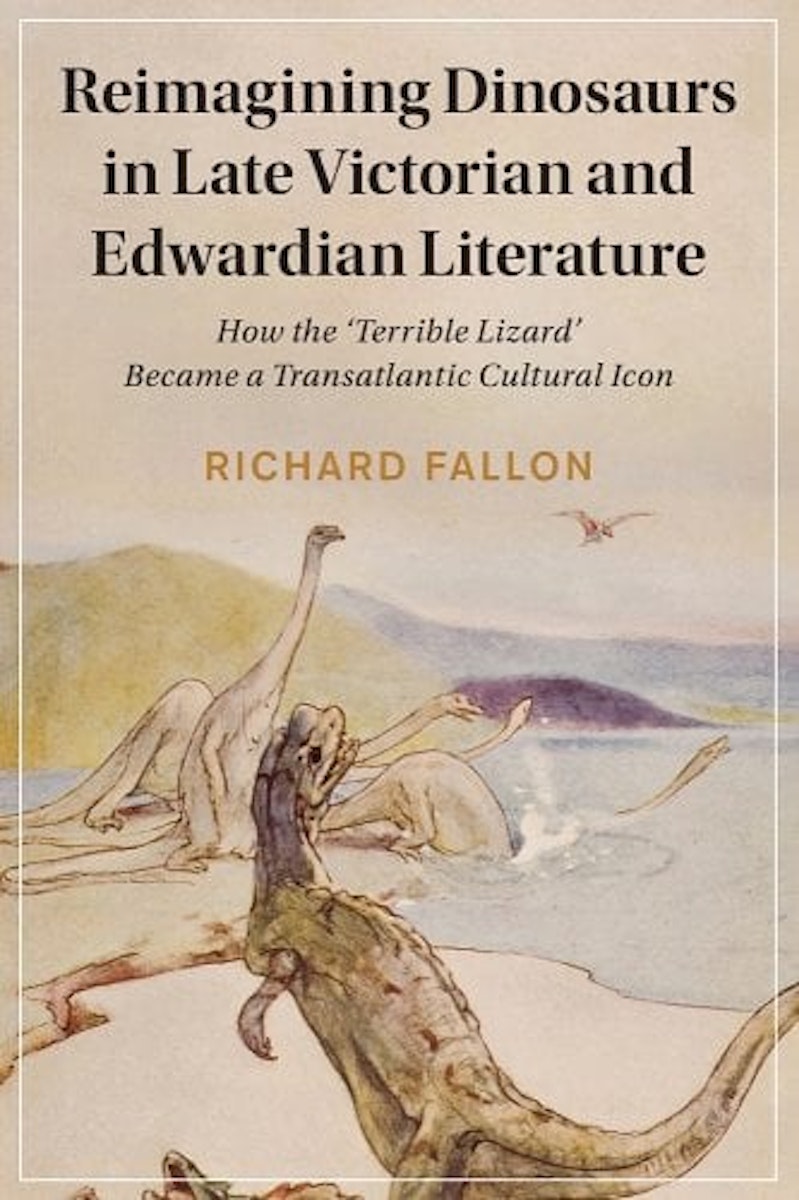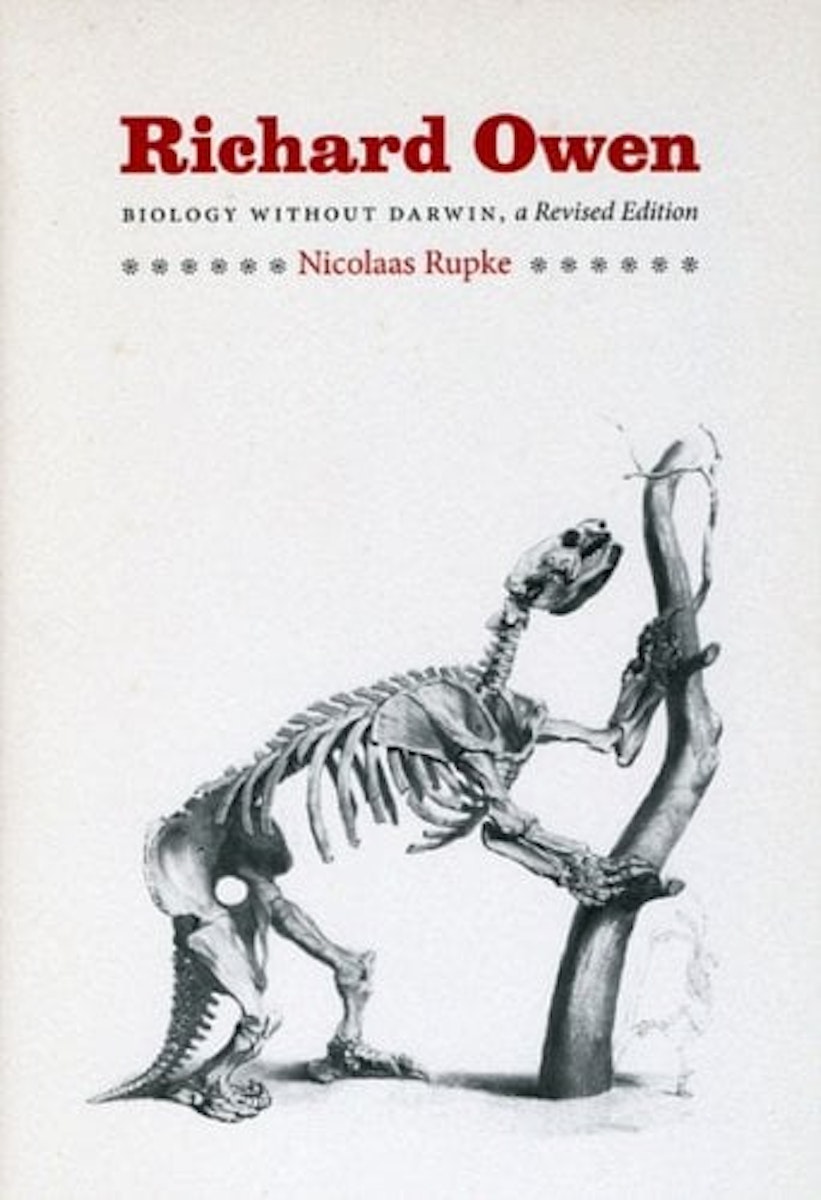
Professor Megalow’s Dinosaur Bones Richard Owen and Victorian Literature
Richard Owen, the Victorian scientist who first named the “dinosaurs”, claimed that he could identify an animal, even an extinct one, from inspecting a single bone. Richard Fallon revisits other Owen-inspired fictions — by R. D. Blackmore, William Makepeace Thackeray, and Charles Kingsley — and finds literature layered with scientific, religious, and political interventions, spurred by the discovery of prehistoric life.
May 2, 2024
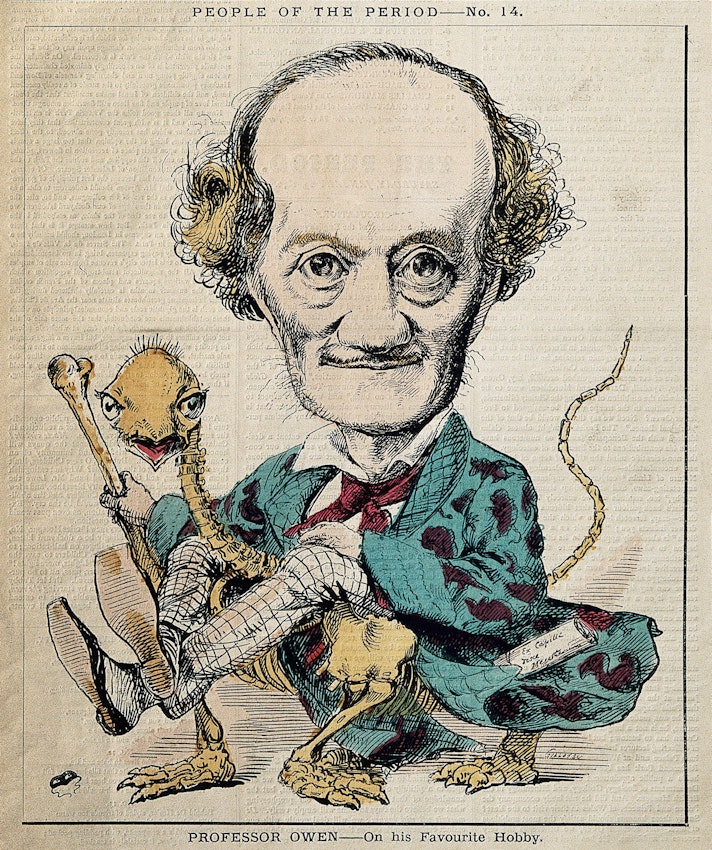 Scroll through the whole page to download all images before printing.
Scroll through the whole page to download all images before printing.“Professor Owen—On his Favourite Hobby”, colour zincograph by F. Gillot from the cover of an 1870 issue of The Period: An Illustrated Review of What Is Going On — Source.
Richard Owen, known today for coining the term “dinosaur” and founding London’s Natural History Museum, was Victorian Britain’s most celebrated comparative anatomist. He was also — to put it diplomatically — a divisive figure. Writing in 1851, one of his various scientific nemeses, Thomas Henry Huxley, considered it “astonishing with what an intense feeling of hatred Owen is regarded by the majority of his contemporaries”.1 Yet, when one of his chief admirers, Richard Doddridge (R. D.) Blackmore, based a character in his latest novel on Owen, that character was intended to epitomize the famous naturalist’s “common sense, kindness and humility”.2 Huxley and Blackmore were evidently seeing very different Owens.
We will return to Blackmore’s intriguing but now largely forgotten novel, The Remarkable History of Sir Thomas Upmore, Bart., M.P., Formerly Known as “Tommy Upmore” (1884), in which Owen is transmuted into the kindly “Professor Megalow”. First, however, it must be asked why the man attracted such variety, and intensity, of feeling. In other words, why did so many fellow naturalists hate his guts? And why did so many titans of literary culture — including not just Blackmore but also Charles Dickens, William Makepeace Thackeray, and many others — find his recondite investigations into zoology and palaeontology so profoundly inspiring?
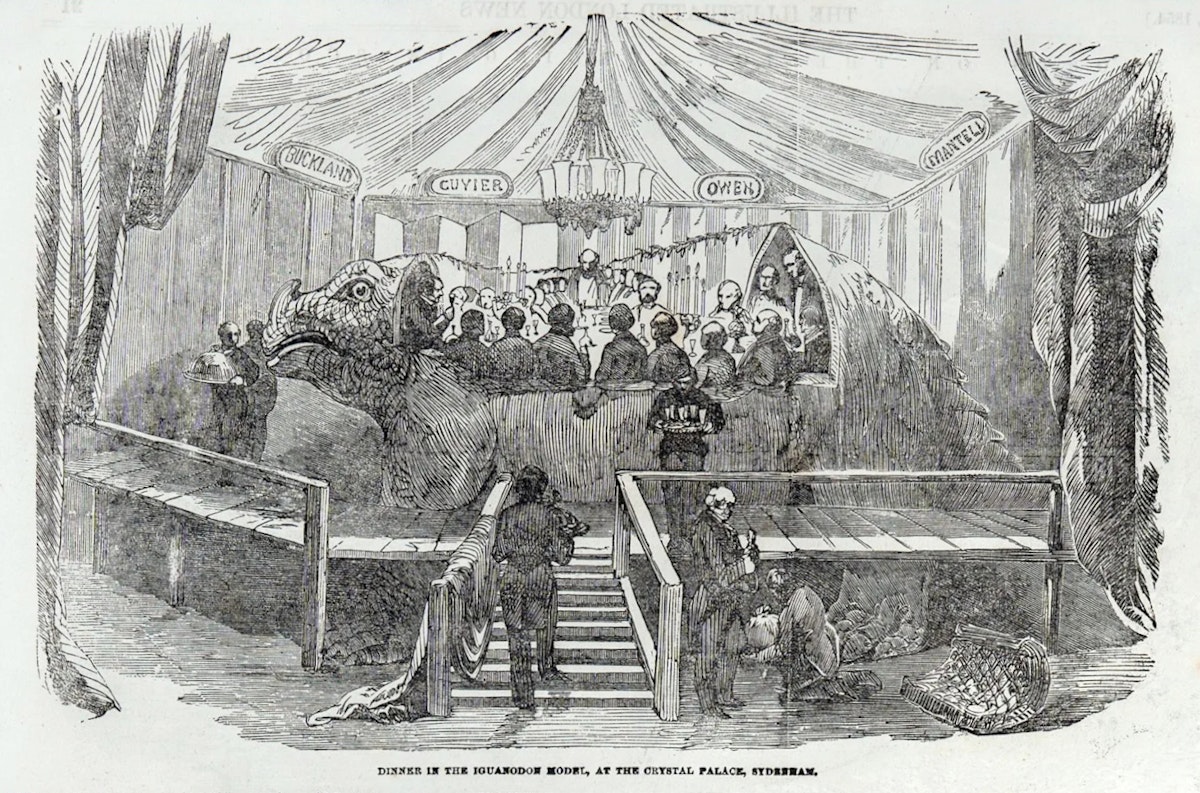 Scroll through the whole page to download all images before printing.
Scroll through the whole page to download all images before printing.“Dinner in the Iguanodon”. On New Year’s Eve, 1853, Owen presides over a meal celebrating the construction of model prehistoric animals at the Crystal Palace in Sydenham. Illustration after Benjamin Waterhouse Hawkins from an issue of Illustrated London News that same year — Source.
Owen rose up from relatively unglamorous family roots in Lancaster, becoming curator, professor, and finally — in 1842 — conservator of London’s well-stocked Hunterian Museum of the Royal College of Surgeons. Superintendency of the natural history collections of the British Museum followed in 1856. Across both spaces, Owen had access to the finest zoological and palaeontological treasures of the ever-growing and ever-acquisitive British Empire. In addition to providing us with the dinosaurs, Owen’s accomplishments included the reconstruction of the New Zealand moa and the giant South American ground sloth Mylodon, pioneering work on the gorilla, and — both before and after the publication of Charles Darwin’s On the Origin of Species (1859) — he postulated innovative if arcane theories of life’s natural development through time.3 Museums were his speciality: Owen’s orchestration of the opening of the Natural History Museum in 1881, absorbing scientific collections formerly housed at the British Museum, capped an illustrious career.
Nonetheless, Owen’s egotism and inscrutability made him enemies in the scientific world from the start. This habit of acquiring adversaries eventually became a serious problem. In the late 1850s, tensions with the rising star Huxley were already foreboding future ill; in 1864, a powerful group calling itself the X Club formed to take charge of science’s role in society and stuck a more persistent thorn in Owen’s side. This influential group of secular scientific naturalists, whose members included Huxley as well as Herbert Spencer, stood for much that Owen detested. Their agnosticism and naturalistic interpretation of evolutionary processes — sometimes understood as driven by what Spencer termed “survival of the fittest”, or what Darwin called “natural selection” — were anathema to Owen’s theistic evolutionism, in which humans represent the apex of God’s providentially unfolding plan. Charles Kingsley’s classic children’s story The Water-Babies (1863) memorably satirized one of the most public clashes between Owen and Huxley, in which the former attempted to distance humans biologically from apes, while the latter, stressing our humble animal descent, did just the reverse.
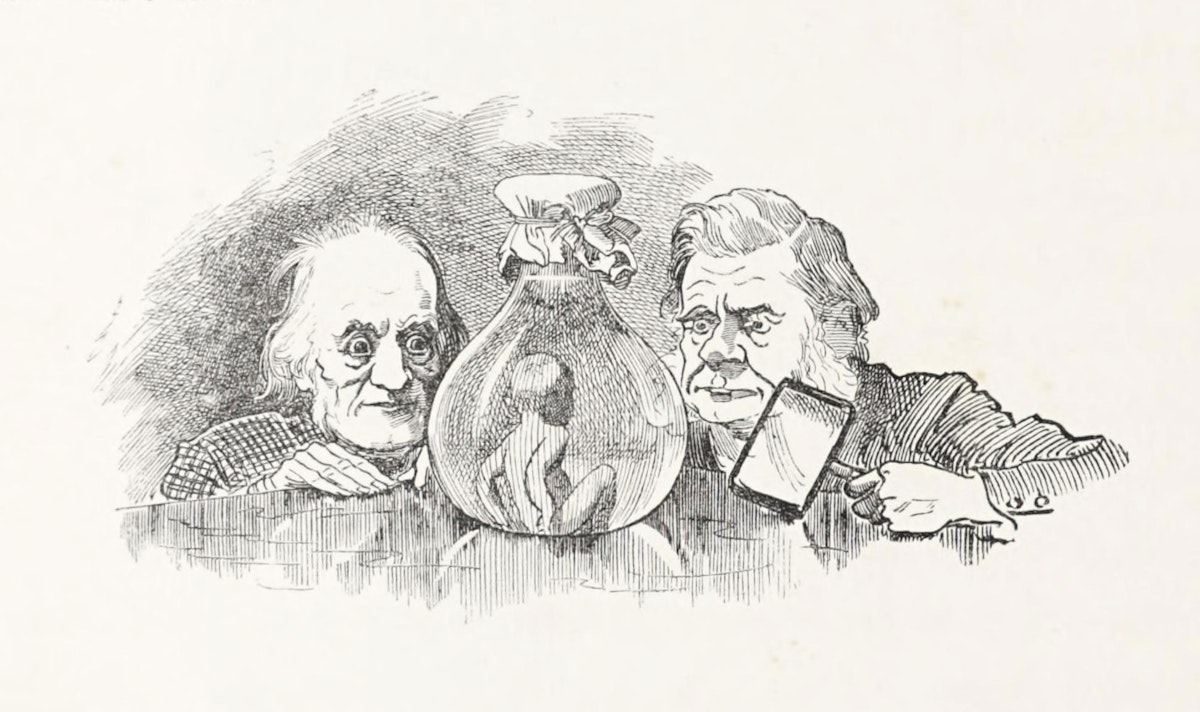 Scroll through the whole page to download all images before printing.
Scroll through the whole page to download all images before printing.Linley Sambourne depicts opponents Owen (left) and Huxley (right) in an 1885 edition of Charles Kingsley’s The Water-Babies — Source.
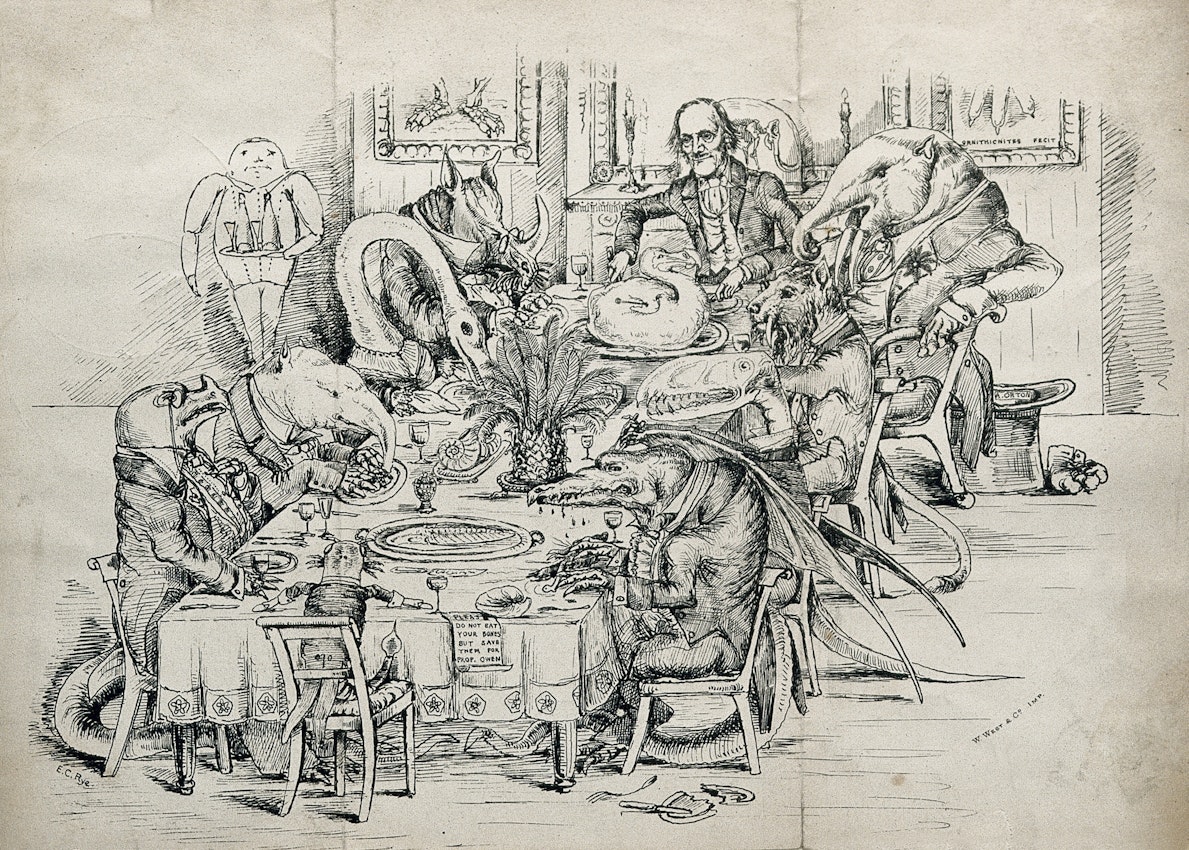 Scroll through the whole page to download all images before printing.
Scroll through the whole page to download all images before printing.Owen dines at the Palaeontographical Society, accompanied by those prehistoric creatures whose fossil bones he knew so intimately. 19th-century lithograph by A. Orton after E. C. Rye — Source.
In addition to espousing a more compartmentalized view of the relationship between science and religion than Owen, and a less compartmentalized view of the relationship between humanity and other animals, those naturalists who came to form the X Club distrusted his pervasive influence over scientific culture. As such, many opposed his ambitious proposals for a separate Natural History Museum. Although he got his museum in the end, acolytes of Darwin and Huxley wrote much of the subsequent history, creating a caricature of Owen as a bigoted obscurantist. Notably, Darwin’s statue currently holds pride of place over Owen’s in the latter’s own museum.
Owen, however, enjoyed propagandistic powers of his own. He came to number leading politicians and members of the royal family among his intimate friends and whipped up excitement for his work in lectures and publications for general readers. Particularly integral to his reputation was the notion that Owen could identify an animal, even an extinct one, from a single bone. His most sensational feat concerned a broken femur found in New Zealand. When it was presented to Owen in 1839, he declared that this femur belonged to a then-unidentified ostrich-like bird. In 1843, further specimens vindicated his apparently audacious prediction and revealed that New Zealand had, indeed, once been infested by these giant, flightless moa birds, which Owen dubbed Dinornis. Contemporaries found this story of scientific wizardry utterly enchanting. The reality, which Owen’s media machine smothered with increasing severity, was slightly more mundane: John Rule, the surgeon who presented Owen with the femur, had already provided evidence for its avian origin.
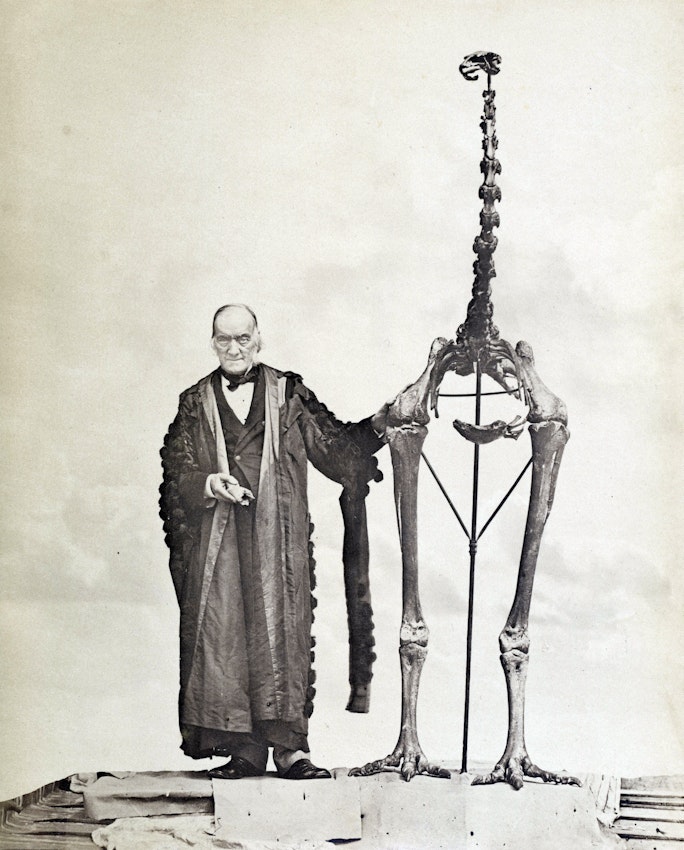 Scroll through the whole page to download all images before printing.
Scroll through the whole page to download all images before printing.Late in life, holding the famous femur in one hand and caressing a moa in another, Owen relives the high point of his career. Halftone after J. Smit after a photograph, ca. 1877 — Source.
Most of Owen’s contemporaries, however, knew nothing of John Rule. As his career thrived in the 1840s, Owen befriended more and more star-studded litterateurs, many of whose works he voraciously consumed in snatches of spare time. This was an era when palaeontological reconstruction, geological time, and extinction were thrilling and still relatively novel notions. Pre-Darwinian controversies over “development” (or, to use a more recognisable term, evolution) raged, while the largely Christian community of British naturalists continued to construct sophisticated ways of making sense of Earth’s history via liberal interpretation of the Book of Genesis — and vice versa. Owen, for his part, was happy to frame his work (or have others frame it) as confirming that even the most apparently monstrous prehistoric creatures were the products of God’s benign design, mysteriously unfolding over sublime aeons of deep time.
Owen’s ability to resurrect these strange animals from inadequate materials struck several leading novelists as an apt analogy for their own literary methods. “How can I tell the feelings in a young lady’s mind; the thoughts in a young gentleman’s bosom?” asks the narrator of William Makepeace Thackeray’s The Newcomes (1854–55). His justification is palaeontological: “As Professor Owen . . . takes a fragment of a bone, and builds an enormous forgotten monster out of it, wallowing in primæval quagmires . . . so the novelist puts this and that together: from the footprint finds the foot; from the foot, the brute who trod on it; from the brute, the plant he browsed on, the marsh in which he swam”.4 For Thackeray, this quasi-scientific pedigree — not entirely proposed in jest — was gratifying, implying as it did that his gigantic works were painstakingly researched and planned.
Dickens was even closer to Owen. His periodicals, including Household Words, published Owen’s articles and promoted the naturalist’s ideas, from his moa mythmaking to his esoteric concept of the ideal “archetype” underlying all vertebrate forms. Nor did Dickens’ novels escape his friend’s osseous influence. Direct reference to Owen in Our Mutual Friend (1864–65) is admittedly limited to a droll description of the complacent Mrs Podsnap, a “fine woman for Professor Owen” possessing “quantity of bone, neck and nostrils like a rocking-horse”; nonetheless, as literary scholars like Gowan Dawson have shown, an Owenian language of palaeontological reassembly pervades this last of Dickens’ completed novels.5 Not least in scenes including the bone collector Mr Venus and the wooden-legged Silas Wegg, the question of conjuring the whole from the part comes to symbolize, as in Thackeray’s The Newcomes, the task of the Victorian serial novelist, who must prove that isolated fragments are all integral contributions to a harmonious and insightful end product.
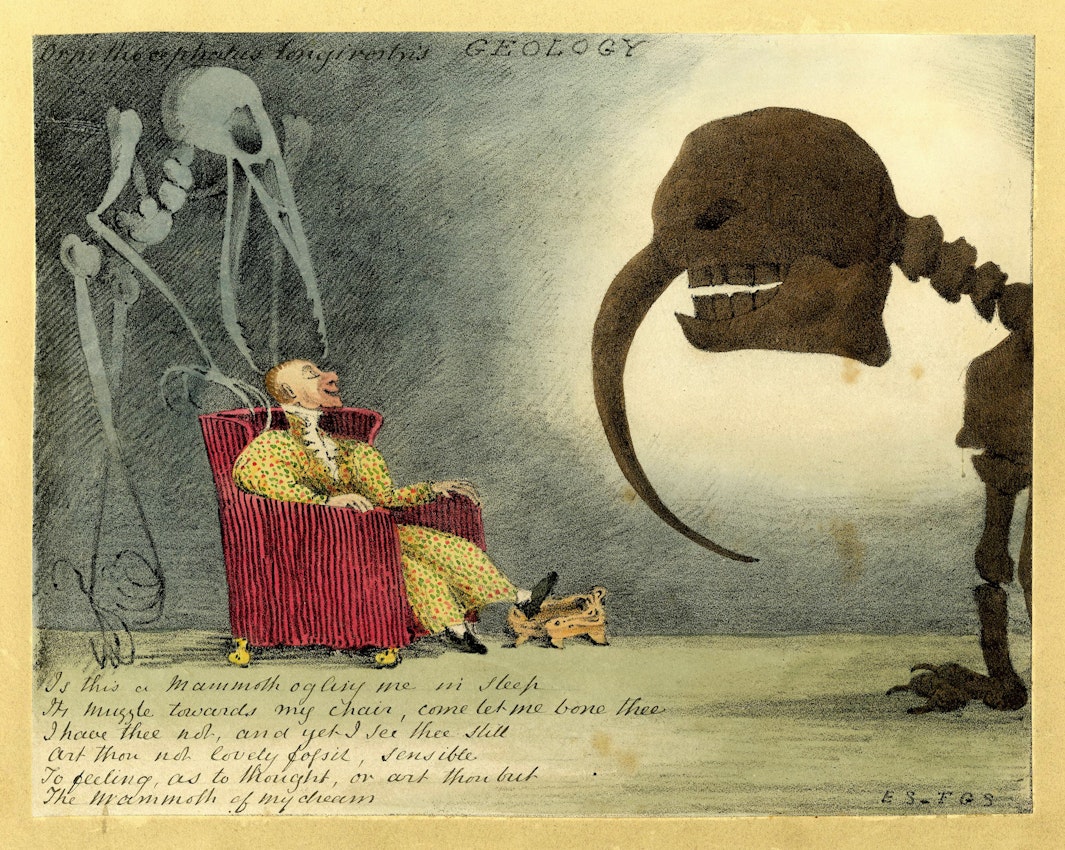 Scroll through the whole page to download all images before printing.
Scroll through the whole page to download all images before printing.Satirical lithograph dating roughly to the 1840s: in a parody of the dagger scene in Macbeth, the dreaming palaeontologist is visited by creatures that he has perhaps, in waking life, striven to reconstruct — Source.
Thackeray and Dickens were just two of the famous authors who extolled Owen in his glory days. In 1884, R. D. Blackmore — to return, as promised, to Sir Thomas Upmore — gave Owen, in the form of “Professor Megalow”, a more prominent role than any author of fiction had ever attempted before, and at a time when the man himself was passing out of fashion. Although he only retired from the Natural History Museum the previous year, Owen’s scientific authority had been besieged for decades. Alienating Darwin and X Clubbers like Huxley had resulted in him being sidelined from many cutting-edge evolutionary discussions of later Victorian science, even if Owen continued to publish elaborate, lavishly illustrated zoological and palaeontological “memoirs” and monographs.
The two Richards — Owen and Blackmore — were fast friends (and fellow chess aficionados), living not far from each other in what is now the London Borough of Richmond upon Thames. Blackmore had previously shot to fame with Lorna Doone: A Romance of Exmoor (1869), a historical romance set in the seventeenth century which remains in print today.6 Sir Thomas Upmore, which stands out among the author’s otherwise substantially rural literary oeuvre, has not enjoyed similar success, and the reasons are not far to seek. The Saturday Review’s critic called it “neither allegory nor novel, neither satire nor romance, but a mixture – not altogether a successful mixture – of all four”.7 Despite, or because of, this generic confusion, it is highly interesting to a present-day reader.
The titular character of Blackmore’s allegorico-romantico-satirico novel, like many fellow Victorian narrators, undertakes an upwardly mobile journey to gentlemanliness. The son of a soap manufacturer, young Tommy Upmore courts Laura, the beautiful daughter of Lady Twentifold of Twentifold Towers. To win the respect of the aristocratic Laura’s politically-obsessed brother, Roland, he must also win a seat as Conservative MP and fight off the onslaughts of Liberals pursuing a dramatic reform agenda. What distinguishes this novel from comparable realist works is its highly fantastic element: due to his body’s abnormal density, Tommy can fly, or rather float. At the end of the novel, he literally rises up above the party-political din in the House of Commons to unite Britain’s politicians in nationalistic fervour.
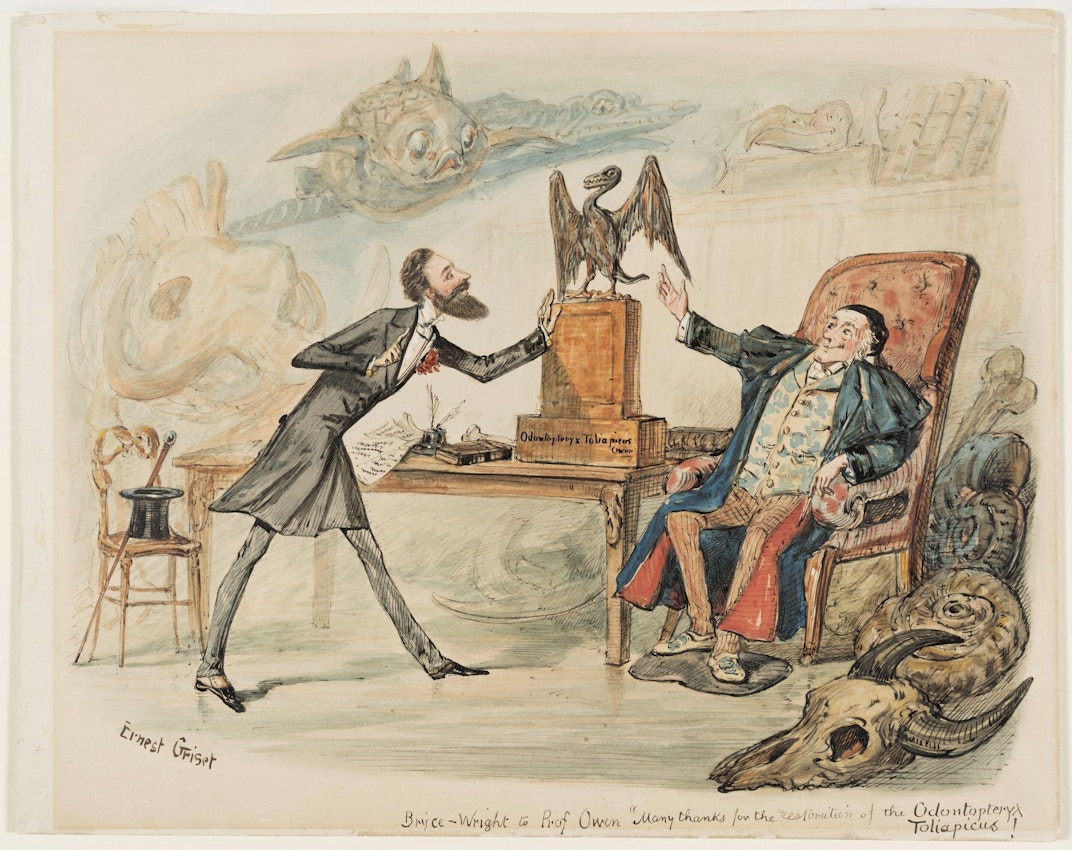 Scroll through the whole page to download all images before printing.
Scroll through the whole page to download all images before printing.Watercolour by Ernest Griset depicting Richard Owen (seated) and the mineralogist Bryce Wright, ca. 1873 — Source.
Despite its protagonist’s ability to float above divisions, Sir Thomas Upmore is hardly a conciliatory novel. Although not as diehard a Tory as Roland, Tommy is shocked at the radical progressive reforms proposed by their Liberal foes (led by the smooth-talking Panclast): “grand measures were being prepared, for a fine subversion of established things; Liberal statesmen being quite convinced by their own condition, that the universe was wrong”.8 Their nefarious plans include the abolition of land ownership, the secession of Britain’s strategic and colonial territories, and even the restitution of plundered artefacts. In addition to swiping at socialists and anarchists, Blackmore caricatured the reforming aims of prime minister W. E. Gladstone’s Liberal government, in power since 1880. In the eyes of the Saturday Review, the novel’s Panclast was “as like Mr. Gladstone as one pea is like another”.9
Science is central to the novel’s conservative political intervention. Blackmore skewers “Professor Brachipod” and the collective of evolutionists brought in to investigate Tommy’s remarkable floating abilities. Insensitive to the boy’s feelings and quick to speculate baselessly about the origin of his powers, these “scientists” — a neologism Blackmore accompanies with scare quotes to indicate his distaste — are impious champions of scientific naturalism, like those men comprising the X Club. Blackmore’s targets are indicated not just by the scientists’ menacing association with vivisection, but also when they help overthrow the traditional classical curriculum of Tommy’s school, replacing it with a new, scientistic syllabus. Both the necessity of vivisection and the need for scientific instruction to accompany — or even replace — classical education, were standard talking points for men such as Huxley.
If Tommy mocks his scientific teachers’ incompetence in the field of ancient Greek and Latin, patrician Lady Twentifold is concerned by something deeper: the apparent atheism of the modern approaches to science they promulgate. “Who brought up this tree?” she asks, gesturing to a grand oak. While some, Tommy observes, would say “Nature”, “Science”, or “Accident”, she prefers to say “that the Almighty made it so”.10 Luckily for both, a more positive model for the scientific practitioner is at hand: Professor Megalow, “whose name shall never be out-rubbed by time”, and whose face, when Tommy first encounters it, appears “the kindest and grandest I had ever seen”.11
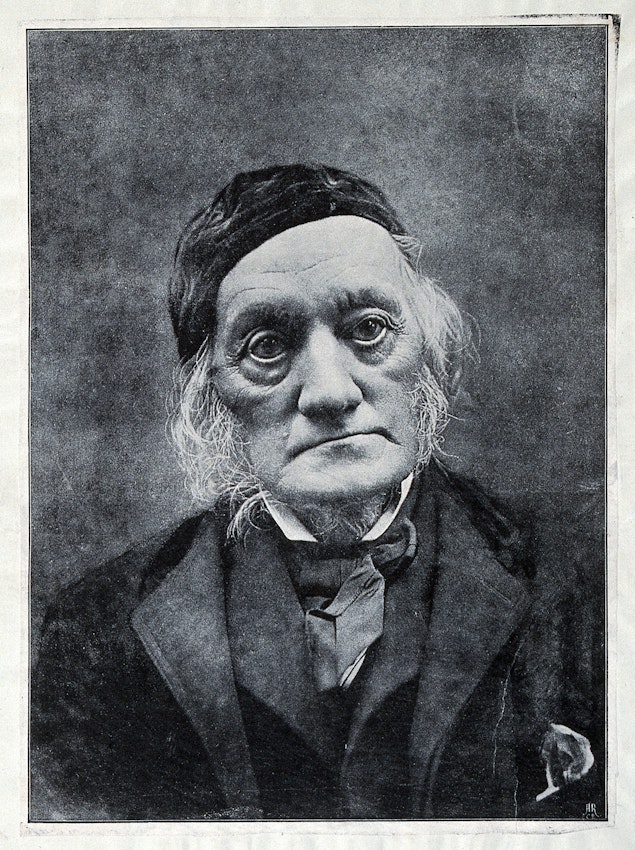 Scroll through the whole page to download all images before printing.
Scroll through the whole page to download all images before printing.Photomechanical portrait of Richard Owen, ca. 1880s — Source.
Megalow is nothing like Brachipod (or their equally oddly named colleagues Jargoon, Chocolous, and Mullicles). A devout Christian, softly spoken, reluctant to construct premature hypotheses, and uninterested in fame or lucre, he dispenses wisdom to Tommy throughout the latter’s career. That Blackmore intended to flatter his friend is undeniable: he even wrote to Owen, asking permission to do so. Megalow was meant to be so recognisable “that the public . . . will exclaim at once ‘this must be Professor Owen’”.12
As the title of an early chapter indicates, Megalow understands “True Science”. He is Blackmore’s ideal scientific practitioner, albeit one at odds with the times. “Even upon subjects, he understands more thoroughly than any other man yet born”, Tommy observes, Megalow “speaks (when he does speak at all) with more doubt, and diffidence, and humility, than a school-girl does, who knows nothing about it, except from one of his own books”.13 Tommy’s old schoolmaster, the classics-obsessed Dr Rumbelow, calls him “a genuine acolyte of that glorious sage, Pythagoras”.14 Himself an enthusiast and one-time tutor of classical literature, as well as a conservative in both politics and religion, Blackmore represented Owen as a reassuring and responsible steward of the era’s dramatic scientific advances.
Megalow’s standout scene takes place when Tommy and Laura help him to excavate a “Deino-Saurian” from a cliff face. It is tempting to suggest that this set piece reflects a growing interest in dinosaurs, catalysed by fossils unearthed in the United States during the 1870s and 1880s, including Brontosaurus and Stegosaurus. Owen himself, after all, had coined “dinosaur” back in 1842 and Megalosaurus was even one of the creatures included in his definition. For most of the nineteenth century, however, general audiences were surprisingly indifferent to the term “dinosaur” and Blackmore’s pedantic spelling suggests that the fossil is to be understood as some rather obscure animal. An arguably more pertinent reference point here is the moa: just as Owen had, according to the myth, predicted the form of the moa and been vindicated years later, the “Deino-Saurian” discovery acts as “tangible proof” of Megalow’s “inductions, published in a treatise ten years ago”.15
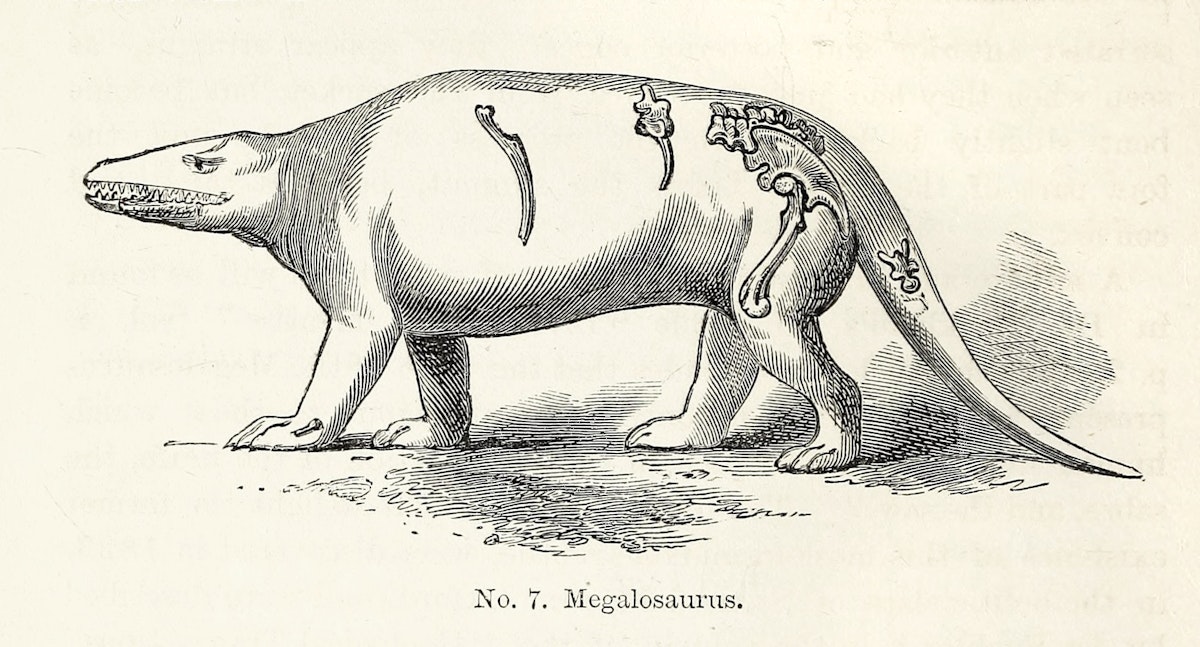 Scroll through the whole page to download all images before printing.
Scroll through the whole page to download all images before printing.Owen’s life-like restoration of Megalosaurus, one of the gigantic extinct creatures he included in his category “Dinosauria” and the origin of the name of Blackmore’s “Professor Megalow”. Illustration from Owen’s Geology and Inhabitants of the Ancient World (1854) — Source.
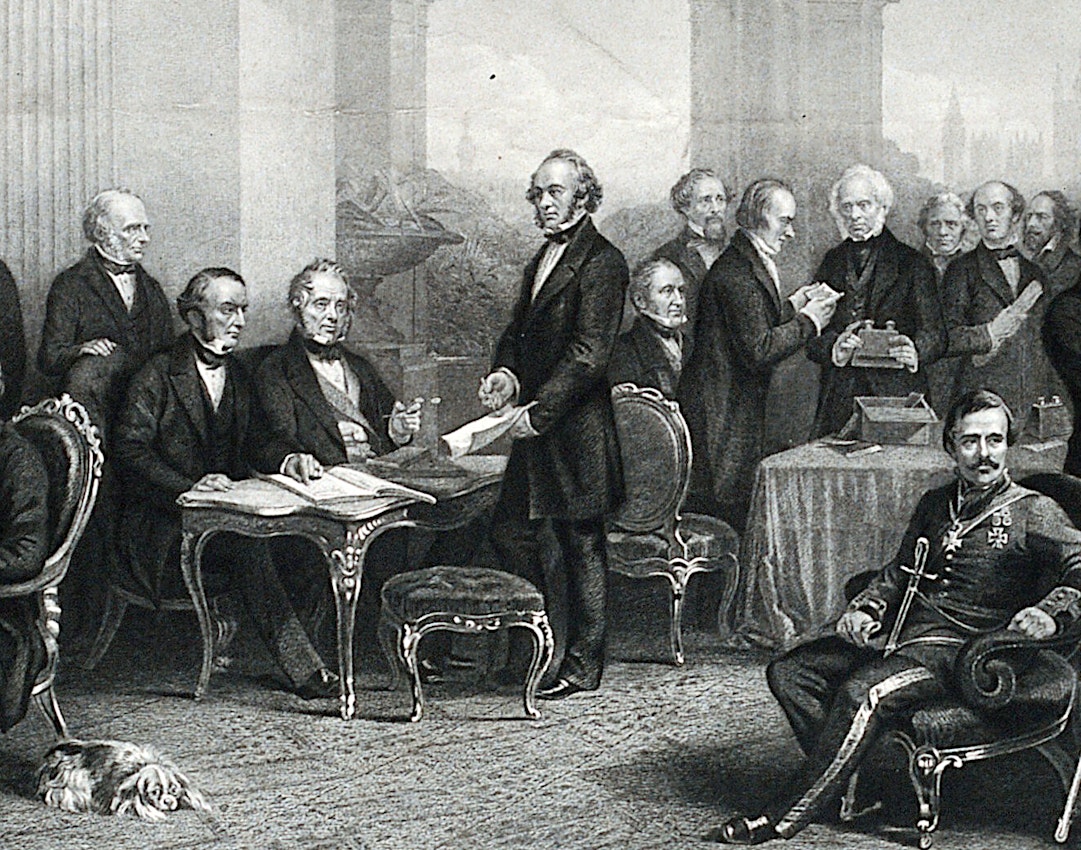 Scroll through the whole page to download all images before printing.
Scroll through the whole page to download all images before printing.Detail from an 1863 engraving by C. G. Lewis after T. J. Barker of notables gathered at Buckingham Palace. Gladstone (left, seated) gestures to a military treaty, while Owen (right, with Dickens at his left shoulder), examines an invention — Source.
Strikingly, Megalow’s method is presented as a third way not just in science but also in the era’s polarized politics. In an otherwise polemical and reactionary novel, Megalow’s Liberal — and worse, “Rad” (Radical) — allegiance is repeatedly stressed. As the ultra-Tory Roland thunders, “[how] can such a great man as the Professor ever have become a Liberal?”16 Indeed, while far from being a revolutionary, the real Owen’s early career had been steeped in the liberal Conservatism of reformist prime minister Robert Peel, who even commissioned a painting of Owen to hang in his country seat, Drayton Manor. In later decades, the Liberal doyen Gladstone himself became a major ally in Owen’s quest to establish the Natural History Museum, as well as supplementing the ageing anatomist’s pension and array of titles.
Admittedly, Tommy’s tolerance for his mentor’s inconvenient political beliefs is enabled by the latter’s reluctance to act upon them: Megalow “was not at all a partisan, or active politician, but quietly held his opinions, upon reasons which satisfied him, and therefore cannot have been weak ones”.17 Attempting conciliation, Tommy concludes that the party governing Britain, “[w]hether it be Radical, or Tory, matters little to the average Englishman; so long as it acts with courage, candour, common sense, and consistency”.18 (And, presumably, doesn’t meddle with landowners or the country’s colonial possessions.)
Sir Thomas Upmore is a fascinating and bizarre text (and, as readers will have noticed, an excellent repository of Victorian character names, including those of Tommy’s father Bucephalus, his friend Bill Chumps, and the formidable Lord Grando Crushbill). Far more so than its young leads and their somewhat perfunctory romance, Professor Megalow lingers with us as the novel’s most compelling character. A modest master of rarefied induction, and unwilling to pursue scientific theories with disruptive social consequences, he represents a safe pair of hands to usher in scientific modernity. This was something of the impression Blackmore absorbed in conversation with his accomplished friend, Owen, making Sir Thomas Upmore one of the century’s greatest love letters to one of its most controversial men of science.
Richard Fallon is a postdoctoral researcher at the Natural History Museum and a knowledge exchange fellow at the University of Nottingham. His research focuses on literary culture’s relationship with geology and palaeontology. Richard received his doctorate in English from the University of Leicester in 2019 and completed a Leverhulme Trust Early Career Fellowship at the University of Birmingham in 2023. His books Reimagining Dinosaurs in Late Victorian and Edwardian Literature (Cambridge University Press) and Creatures of Another Age (Richmond, VA: Valancourt Books) were published in 2021.





